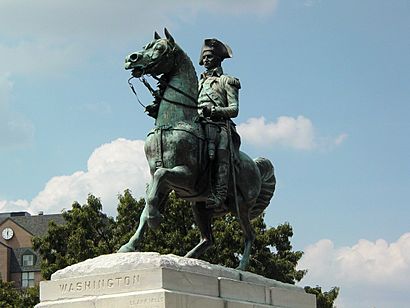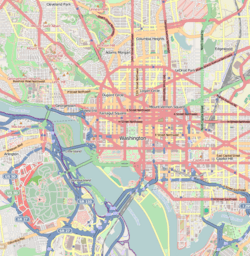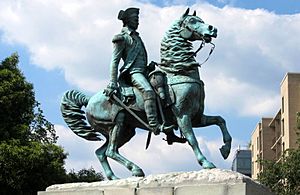Equestrian statue of George Washington (Washington Circle) facts for kids
Quick facts for kids Lieutenant General George Washington |
|
|---|---|
 |
|
| Artist | Clark Mills |
| Year | 1860 |
| Type | Bronze |
| Dimensions | 2.7 m × 4.3 m × 1.8 m (9 ft × 14 ft × 6 ft) |
| Location | Washington Circle, Northwest, Washington, D.C., United States |
| Owner | National Park Service |
|
Equestrian statue of George Washington
|
|
|
U.S. Historic district
Contributing property |
|
| Location | Stanton Park, Northeast, Washington, D.C. |
| Part of | American Revolution Statuary. (ID78000256) |
| Added to NRHP | July 14, 1978 |
This article is about the famous statue of George Washington in Washington, D.C. The statue is called Lieutenant General George Washington. It shows George Washington riding a horse. The statue was made in 1860 by a sculptor named Clark Mills. You can find it at Washington Circle, near the George Washington University campus in Washington, D.C..
Contents
History of the George Washington Statue
The idea for a statue of George Washington came about a long time ago. In 1783, after the American Revolutionary War ended, the Continental Congress wanted to build a statue of Washington on horseback. They wanted the statue's base to show important moments from the war.
Early Plans and Delays
However, the plan for the statue was put on hold for many years. After Washington passed away in 1799, Congress decided again that a marble monument should be built. This plan also faced delays. In 1800, they thought about building a grand tomb instead. Finally, in 1801, money was set aside for the project, but the statue still wasn't built.
Bringing the Idea Back to Life
The idea for the statue came back in 1832. A congressman named James Buchanan (who later became president) asked why the 1799 plan hadn't been carried out. The House of Representatives then formed a committee. This committee was meant to plan celebrations for the 100th anniversary of Washington's birth. This event helped bring the idea of honoring George Washington with a statue back into focus.
Building and Dedicating the Statue
The equestrian statue was finally approved by Congress on January 25, 1853. The famous sculptor Clark Mills was chosen to create it. The statue was officially dedicated on February 22, 1860. President Buchanan, the same person who had asked about the original plan years earlier, was there for the dedication. The statue cost $60,000 to build.
What the Statue Shows
The statue shows George Washington riding his horse. He is pictured moving forward, as if leading American troops against the British. Cannonballs and shots are around him, like during the Battle of Princeton and Trenton. Washington looks calm and determined as he holds the reins and watches the battle.
The horse's flowing mane in the statue was inspired by a famous painting called Napoleon Crossing the Alps.
Washington's Military Ranks
During the Revolutionary War, George Washington's main title was "General and Commander-in-Chief." He was not a "Lieutenant General" at that time. However, in 1798, during a time of tension with France called the Quasi-War, he was appointed to lead the army with the rank of lieutenant general. This is why the statue is titled Lieutenant General George Washington.
Moving the Statue
For over a century, the statue stood proudly in Washington Circle. In 1936, it was temporarily moved. This was done to allow for the building of the K Street Underpass, a road tunnel. After the construction was finished, Washington and his horse were returned to their spot in the center of Washington Circle.
National Recognition
This statue is an important part of the American Revolution Statuary in Washington, D.C. Because of its historical value, it is officially listed on the National Register of Historic Places.
See also
 In Spanish: Estatua ecuestre de George Washington (Washington Circle) para niños
In Spanish: Estatua ecuestre de George Washington (Washington Circle) para niños



